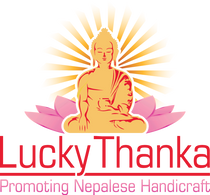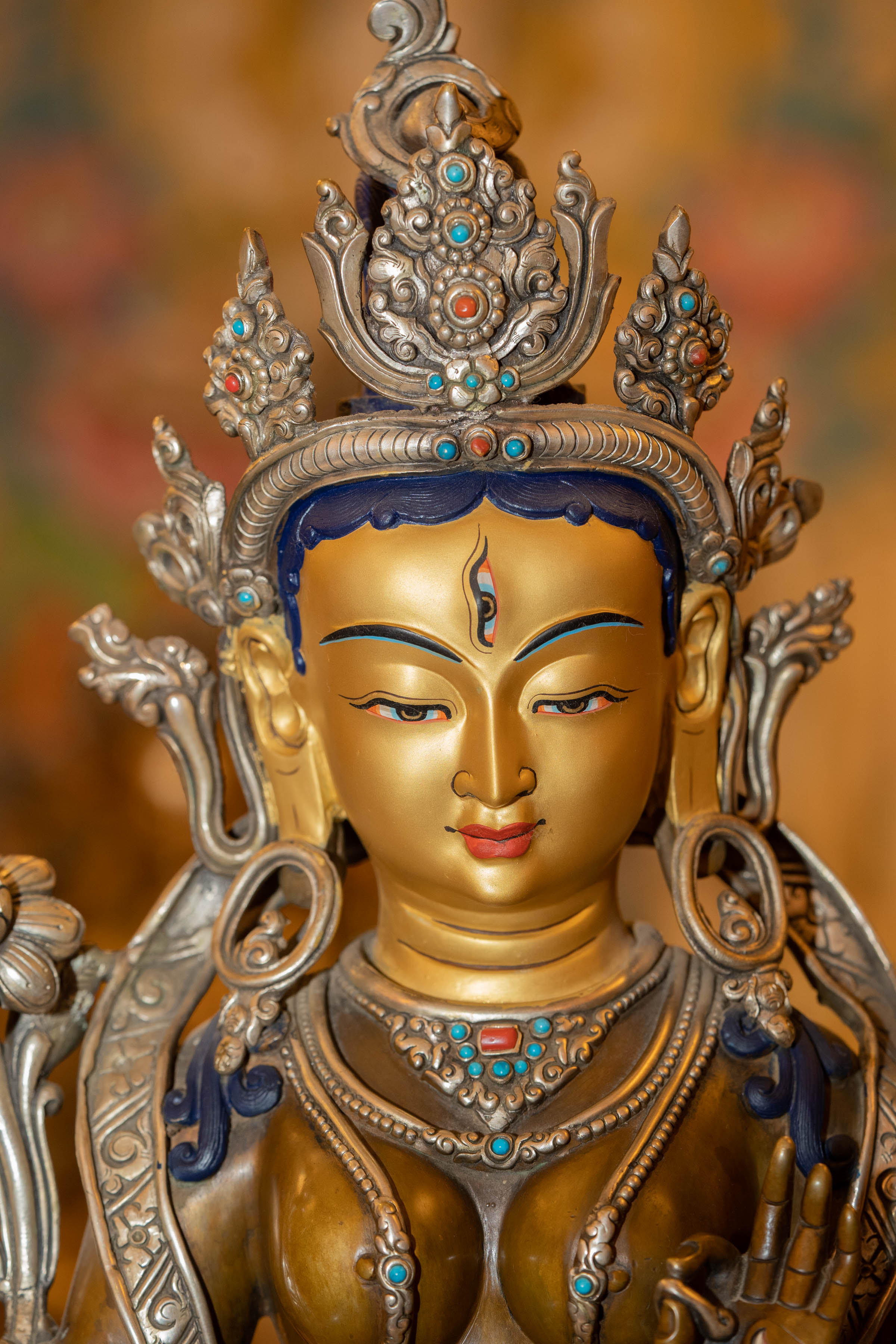 Manjushri is the personification of the wisdom required to become a Buddha. Manjushri was the monarch of a land named Kamjung Sangpo many eons ago. He took bodhisattva vows, renounced his kingdom and worldly goals, and developed the awakened mind. Finally, he acquired total enlightenment and became Manjushri, Lord of Wisdom. Manjushri is the personification of the wisdom needed to become a Buddha. Manjushri was the monarch of a land named Kamjung Sangpo many eons ago. He took bodhisattva vows, renounced his kingdom and worldly goals, and developed the awakened mind. Finally, he acquired perfect enlightenment and became Manjushri, the Lord of Wisdom, as we know him today.
Manjushri is the personification of the wisdom required to become a Buddha. Manjushri was the monarch of a land named Kamjung Sangpo many eons ago. He took bodhisattva vows, renounced his kingdom and worldly goals, and developed the awakened mind. Finally, he acquired total enlightenment and became Manjushri, Lord of Wisdom. Manjushri is the personification of the wisdom needed to become a Buddha. Manjushri was the monarch of a land named Kamjung Sangpo many eons ago. He took bodhisattva vows, renounced his kingdom and worldly goals, and developed the awakened mind. Finally, he acquired perfect enlightenment and became Manjushri, the Lord of Wisdom, as we know him today.
Forms of Manjushri in Buddhism

Manjushri is considered as a supremely wise bodhisattva. In the Buddhist pantheon, he is shown as a sixteen-year-old lad to signify wisdom. Ideas arise from the expansion of intellectual brilliance, which penetrates straight to the core of reality, rather than from ordinary experience. Manjushri appears in five distinct Tantric forms, which are described below:
Simhanada Manjushri
This form represents a red-haired form of Manjushri with four limbs and a single face. The right hand holds a blazing sword and an arrow. The lotus stem, the book on top of the flower, and the bow are all held in the left hand. Red Manjushri is a famous depiction, sitting cross-legged on a lotus-flower throne and dressed with royal silks and diamonds.
Tikshna Manjushri
Green Manjushri is another name for Tikshna Manjushri. His body is yellow and he has one face and two arms. On the lotus stems, the knowledge sword is on the right, and the wisdom book is on the left (Utpala). He is dressed in silks and diamonds and sits with his feet in the vajra pose.
Arapacana Manjushri
This version of Manjushri has a special connection to Kathmandu Valley since he drained the valley's water to make it habitable. Manjushri has a single face and is shown in the center in this shape, showing his non-dual knowledge. In his right hand, he wields a knowledge sword, signifying the severance of the root of delusion, the cause of grief, ignorance, and self-grasping. He has a holy text called "Perfection of Wisdom" that purges all illusions. In Vajraparyanka position, he is sitting.
Vimala Manjushri
Vimala Manjushri, Manjushri's wrathful healing form, is employed to clear both internal and external impediments. This Manjushri represents a single face and a blue-black body with two limbs. A sword blazing with fire is raised to the heavens by the right hand, cutting ignorance. While holding the wisdom book above, the left hand grips the stem of a utpala.
Jnanasattva Manjushri
Manjushri is also known as Jnanasattva Manjushri, the deity of wisdom in this incarnation. His body is white and he has one face and two arms. He shows himself in this shape with his legs crossed in vajra posture, his right hand in the mudra of great generosity, and his left hand gripping the stem of a lotus on which a burning sword rests. White Manjushri has the fundamental trait of a book resting on a utpala flower, several faces and arms, or riding a lion in different variations.
How Did Manjushri Form Kathmandu Valley?
In Nepal, he is revered as the builder of Kathmandu Valley and the originator of Nepalese civilization. According to legends, the god of wisdom, Manjushri was a Chinese Saint before. His intuition told him about a blue flame on a lotus in Nepal's huge lake symbolizing Adibuddha or Swayambhu. To drain the lake, he carved a chasm with his blazing sword. People have been able to dwell in the Kathmandu valley since then. Manjupattan is thought to be the name of the earliest human habitation in the Kathmandu valley.
Manjushri traveled from China and spent three nights on Mahamandap, a hill east of Bhaktapur, where she witnessed the "Swayambhu lights." He determined that he wanted to go closer to the source of the light, so he built a gorge at Chobhar to drain the Nagdaha (lake of spirited serpents). Manjushri put his two goddesses, Barda and Makshada, atop Phulocha and Dhyanchha, with himself in the center. The mountain, which he named Kotwal, was then cut through. Several nags and other creatures dwelling in the tank fled, but he convinced Karkotaka, the king of nags, to stay, and on Mesh Sankranti day, after showing him a huge tank to live in Taudaha, he donated the tank to him.
Manjushri is frequently linked with Buddhist tantric practice.
Manjushri, according to Pandit Hem Raj Shakya's book Sri Swayambhu Mahachaitya, was well-versed in all disciplines of science and desired to approach the brilliant light of the self-born-one (Swayambhu) after seeing it.
Thangka Painting Depiction
Manjushri is often shown as a male Bodhisattva with a blazing sword in his right hand, indicating the pinnacle enlightenment of transcendent knowledge that eliminates duality, sorrow, and ignorance. Manjushri's achievement of ultimate realization through the flowering of knowledge and wisdom is symbolized by the sacred text supported by the lotus (padma) carried in his left hand, the Prajnaparamita sutra (the Perfection of Wisdom).
Majur is frequently represented as riding a blue lion, sitting on a lion's hide or in an elephant. This signifies the application of knowledge to the mind's control. Avalokitevara and Vajrapani are frequently represented as a triad with Majur. Manjushri is considered the most important and oldest bodhisattva. His pure land is expected to be one of the two greatest pure lands in the entire universe, past, present, and future.
Manjushri is also represented as a sixteen-year-old boy as a bodhisattva. This demonstrates that wisdom is a direct result of anyone's rational enquiry into the underlying nature of reality, rather than being connected with maturity and age.
Prajna Parmita Meaning In Manjushri
The Prajna Paramita, also known as the Perfection of Wisdom, is primarily concerned with the Sanskrit term Prajna or the Pali term Panni. Wisdom is translated as Prajna, and Prajna Paramita is the perfection of Wisdom.
In Buddhism, wisdom is defined as one's perspective on the nature of genuine reality, which includes Dukkha (pain and suffering), sunyata (enlightenment), and sunyata (enlightenment) ( emptiness ). Prajna paramita is the most difficult of the Paramita teachings because grasping the sunyata or emptiness is difficult, and many Buddhist monks have misinterpreted the genuine truth and true meaning of this phrase " Sunyata ". Sunyata, or Emptiness, is regarded the essence or heart of most Mahayana Buddhist beliefs.
The Prajnaparamita sutra, which is held by the lotus (padma) in Manjushri's left hand, represents Manjushri's achievement of ultimate realization via the blossoming of knowledge and wisdom (the Perfection of Wisdom). The Prajnaparamita sutra, which is held by the lotus (padma) in Manjushri's left hand, represents Manjushri's achievement of ultimate realization via the blossoming of knowledge and wisdom (the Perfection of Wisdom).
Understanding the Meaning of Manjushri Mantra
Manjushri's mantra expresses the characteristic of knowledge, which he represents as a Bodhisattva. The Manjushri mantra grasps the following lines:
OM: Om is a sacred syllable in Hinduism and other religions, especially in India, that is regarded the greatest of all mantras, or sacred formulae. Om is composed of three words A-U-M which is sacred and mystical. This mystical word represents the essence of the entire cosmos in a magical way. It's said at the start and conclusion of Hindu prayers, chants, and meditations, and it's also used freely in Buddhist and Jain ceremonies.
AH: refers as a gateway to the realisation that all dharmas are produced from the start.
RA: From a Hinayana perspective, it signifies the awareness of emptiness. These profound teachings on emptiness from the "Hinayana" are appropriate for practitioners who are having difficulty grasping emptiness in its ultimate form.
BA: is a gateway to the realisation that all dharmas have been taught in their most complete form (paramrtha).
TSA: This mystical word symbolises the significance of Peace/nirvana and samsara. Both samsara and nirvana are characterised by emptiness. However, if we do not comprehend the true essence of samsara, it arises in three forms. It's critical to comprehend the significance of both nirvana and samsara.
NA: reflects the concept of karma (action). In a nutshell, it means that all of our suffering is the consequence of our prior non-virtuous activities (negative karma) and that all of our happiness is the result of our previous virtuous efforts (positive karma) (positive karma). Karma is divided into two types: community karma and individual karma. We must realise that every action we take with our words, bodies, and minds sows the seeds of our future experience.
DHI: DHI is the seed syllable of the Boddhisatva Manjushri's bij. Imagine the dhi on your tongue descending down and integrating into the dhi on the moon disk at your heart, which becomes exceedingly bright, after chanting 108 dhihs. From that seed syllable, incalculable red-light rays emanate, filling your entire physical body and purging all negative karma (actions), disease, and difficulties.
As to conclude, the vision aids us in identifying the proper way. Meditation is the real practice of developing an experienced comprehension of the path, which leads to a shift in our thoughts and feeling.
When activity is joined with wisdom, we have the ability to serve sentient creatures in an efficient and timely manner. Fruition is the joy and confidence that comes from carrying out our good goals.
Understanding the Benefits of Manjushri Mantra
All of Boddhisatva Manjushri's practices are extremely effective at clearing our ignorance and delusions, as well as improving our learning abilities, debate, writing, memory, and wisdom.
This mantra should be recited 100, 21, or at least 7 times, according to one ancient Tibetan tradition. On the last iteration, the final syllable, DHI, should be sung as many times as feasible (mentally or loudly).This mantra is excellent for gaining knowledge and penetrating insight in order to combat ignorance. It also symbolizes the culmination of our spiritual work, which melts the ice of our samsaric mind into water, revealing its true Buddha-nature.



